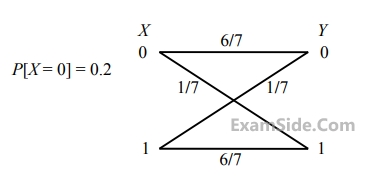1
GATE ECE 2016 Set 1
Numerical
+2
-0
A digital communication system uses a repetition code for channel encoding/decoding. During transmission, each bit is repeated three times (0 is transmitted as 000, and 1 is transmitted as 111). It is assumed that the source puts out symbols independently and with equal probability. The decoder operates as follows: In a block of three received bits, if the number of zeros exceeds the number of ones, the decoder decides in favor of a 0, and if the number of ones exceeds the number
of zeros, the decoder decides in favor of a 1, Assuming a binary symmetric channel with crossover probability p = 0.1, the average probability of error is _______
Your input ____
2
GATE ECE 2015 Set 2
MCQ (Single Correct Answer)
+2
-0.6
Consider a binary, digital communication system which uses pulses g (t) and − g (t)for transmitting bits over an AWGN channel. If the receiver uses a matched filter, which one of the following pulses will give the minimum probability of bit error?
3
GATE ECE 2015 Set 1
Numerical
+2
-0
The input X to the Binary Symmetric Channel (BSC) shown in the figure is ‘1’ with probability 0.8. The cross-over probability is 1/7. If the received bit Y = 0, the conditional probability that ‘1’ was transmitted is _______.


Your input ____
4
GATE ECE 2015 Set 1
MCQ (Single Correct Answer)
+2
-0.6
A source emits bit 0 with probability $${1 \over 3}$$ and bit 1 with probability $${2 \over 3}$$. The emitted bits are
communicated to the receiver. The receiver decides for either 0 or 1 based on the received value R. It is given that the conditional density functions of R are as
$${f_{\left. R \right|o}}\,(r) = \left\{ {\matrix{ {{1 \over 4},} & { - \,3\,\, \le \,\,x\,\, \le \,\,1,\,} \cr 0 & {otherwise,} \cr } } \right.and$$
$${f_{R/o}}\,(r) = \left\{ {\matrix{ {{1 \over 6},} & { - \,1\,\, \le \,\,x\,\, \le \,\,5\,,} \cr 0 & {otherwise.} \cr } } \right.$$
$${f_{\left. R \right|o}}\,(r) = \left\{ {\matrix{ {{1 \over 4},} & { - \,3\,\, \le \,\,x\,\, \le \,\,1,\,} \cr 0 & {otherwise,} \cr } } \right.and$$
$${f_{R/o}}\,(r) = \left\{ {\matrix{ {{1 \over 6},} & { - \,1\,\, \le \,\,x\,\, \le \,\,5\,,} \cr 0 & {otherwise.} \cr } } \right.$$
The minimum decision error orobability is
Questions Asked from Marks 2
GATE ECE 2025 (1) GATE ECE 2016 Set 1 (2) GATE ECE 2015 Set 2 (1) GATE ECE 2015 Set 1 (2) GATE ECE 2014 Set 4 (2) GATE ECE 2014 Set 2 (1) GATE ECE 2013 (1) GATE ECE 2012 (2) GATE ECE 2011 (2) GATE ECE 2010 (2) GATE ECE 2009 (2) GATE ECE 2008 (1) GATE ECE 2007 (5) GATE ECE 2006 (2) GATE ECE 2005 (3) GATE ECE 2004 (1) GATE ECE 2003 (2) GATE ECE 2001 (1) GATE ECE 1999 (2) GATE ECE 1988 (2) GATE ECE 1987 (1)
GATE ECE Subjects
Signals and Systems
Network Theory
Control Systems
Digital Circuits
General Aptitude
Electronic Devices and VLSI
Analog Circuits
Engineering Mathematics
Microprocessors
Communications
Electromagnetics



